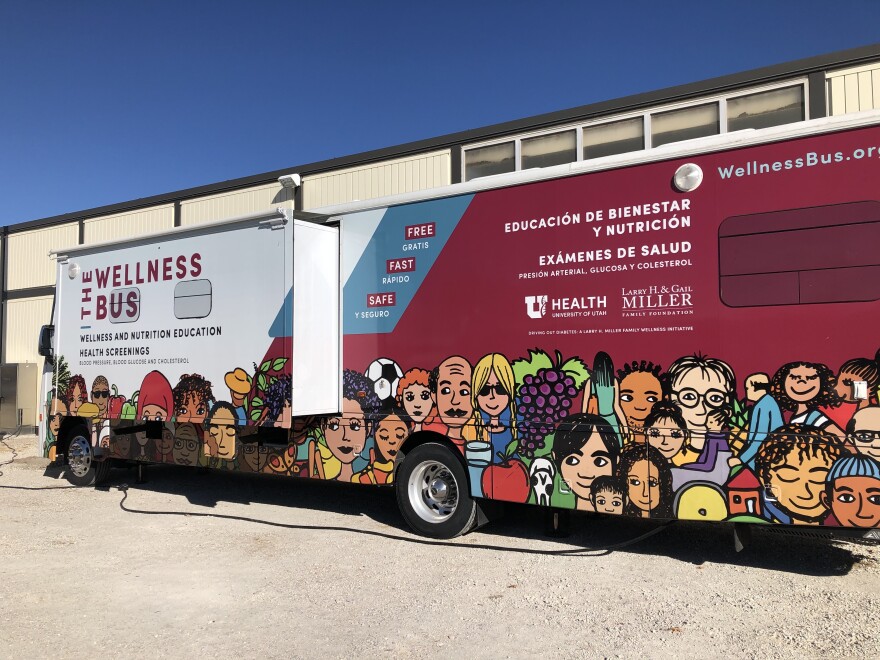Fourteen-year-old Angel Ocampo lives in Layton. But on a Thursday morning in December, he was in Salt Lake City sitting in the passenger seat of his family’s minivan next to his mom. They were driving through a barn at the Utah State Fairpark being used as a drive-through COVID-19 test site. Two lines of cars thread their way between rows of empty metal animal stalls.
“My mom tested positive,” Ocampo said. “[That's] the reason why we’re here.”

They made the 25-minute drive to this facility for two reasons. First, because Ocampo’s mother doesn’t speak English and there’s staff at Fairpark that speak Spanish.
But most importantly, they don’t have health insurance, and they can get tested here for free. In fact, 30% of Hispanic Utahns did not have health insurance last year, according to the Utah Department of Health.
“I think it's good that people who have, like, no resources or access and no income can come and get tested,” Ocampo said, “so they keep their family safe.
At its peaks in April and June, nearly 60% of new COVID-19 cases in Utah came from the Hispanic and Latinx community, even though they make up only 14% of the state’s population.
They now make up just about 15% of new cases. State officials credit increased and accessible testing like the location Ocampo’s at for helping close that gap, but health disparities still exist.
The Fairpark site is run by the University of Utah’s Wellness Bus. Prior to the pandemic, it was a mobile health clinic that drove around the west side of the Salt Lake Valley.
Ocampo said when his family lived in this area, his mom would visit the bus and that’s how they found out about the test site.
Systemic Barriers

Robin Marcus is the Chief Wellness Officer for University of Utah Health and helps run the bus. On the morning Ocampo was getting tested, Marcus was at the Fairpark helping everything run smoothly, from putting labels on saliva collection tubes to checking in with people working there.
Marcus said the Fairpark testing site is important for helping Hispanic and Latinx Utahns, a community that has been hit by COVID-19 disportionately hard.
“There's a pretty long history of challenges to trust between underserved minorities and traditional health care systems,” she said. “So I think that having a site like this where they know that we've been in their communities for now almost three years really helps to kind of overcome that barrier of trust.”
One reason that COVID-19 spread among racial minorities has been consistently higher than among white residents, according to Tom Hudachko with the Utah Department of Health, is because it’s harder for them to socially distance.
A report from the Centers for Disease Control and Prevention found “the overrepresentation of Hispanic and nonwhite workers in frontline occupations” led to those communities having disportionately high rates of the virus.
“People who work in an office setting, where they can be physically distant from one another or where they can telework, are more likely to be able to protect themselves from the infection than from individuals who work in settings where they have to show up on the job,” Hudachko said.
Continuing Health Disparities
Although Utahns that identify as Hispanic or Latinx make up a smaller percentage of COVID-19 cases now than they did during the spring, the virus is still widespread within the community. They have the second highest positivity rate of any racial group in Utah — 28%.
That’s more than double the rate of white people in the state. Hudachko said that means there’s a lot of undetected cases out there.
There are currently at least five testing places on the west side of the Salt Lake Valley that don’t require health insurance. But Comunidades Unidas program director Yehemy Zavala Orozco argues those locations need to stay open longer.
“You will see that there is a lot of testing opportunities for people to do it Monday through Thursday or Monday through Friday and the times at 8 a.m. to 1 or 2 p.m.,” they said. “Those are the times our community members are working. And, you know, they have to choose between getting the testing done or providing food for their families.”
There’s also, Orozco said, programs that require social security numbers, a lack of bilingual doctors, and the high cost of healthcare, especially going to hospitals. That’s something they said promotoras— or community health workers— at Comunidades Unidas hear all the time.
“Some of them, they told us this: ‘I'd rather die with COVID than going to the hospital and leaving my family with that debt that they cannot pay,” Orozco said. “It just breaks my heart.”
Even though huge barriers still exist, Ozorco said they’re proud of the work that Comunidades Unidas has done. The fact that Hispanic or Latinx Utahns have gone from making up 60% of the state’s cases to just 15% is evidence they’re making progress, Orozco said.
That work has been possible due to the money they received from the federal CARES Act earlier this year, but that funding runs out next week.
Although Congress has agreed to a new relief package, Orozco said right now, it doesn’t change anything for Comunidades Unidas, because they aren’t guaranteed to receive any more funding before Dec. 30, if at all.
“It means that we will have to lay off community health workers — we will have to lay off promotora,” Orozco said. “And we will have to decrease the amount of messaging and information that we provide to our community members because of that … we are terrified.”
Right now layoffs are still scheduled for next week.
Orozco said they’re worried that when they have to scale back their COVID-19 response, rates of the disease in the Hispanic and Latinx community could get worse.




